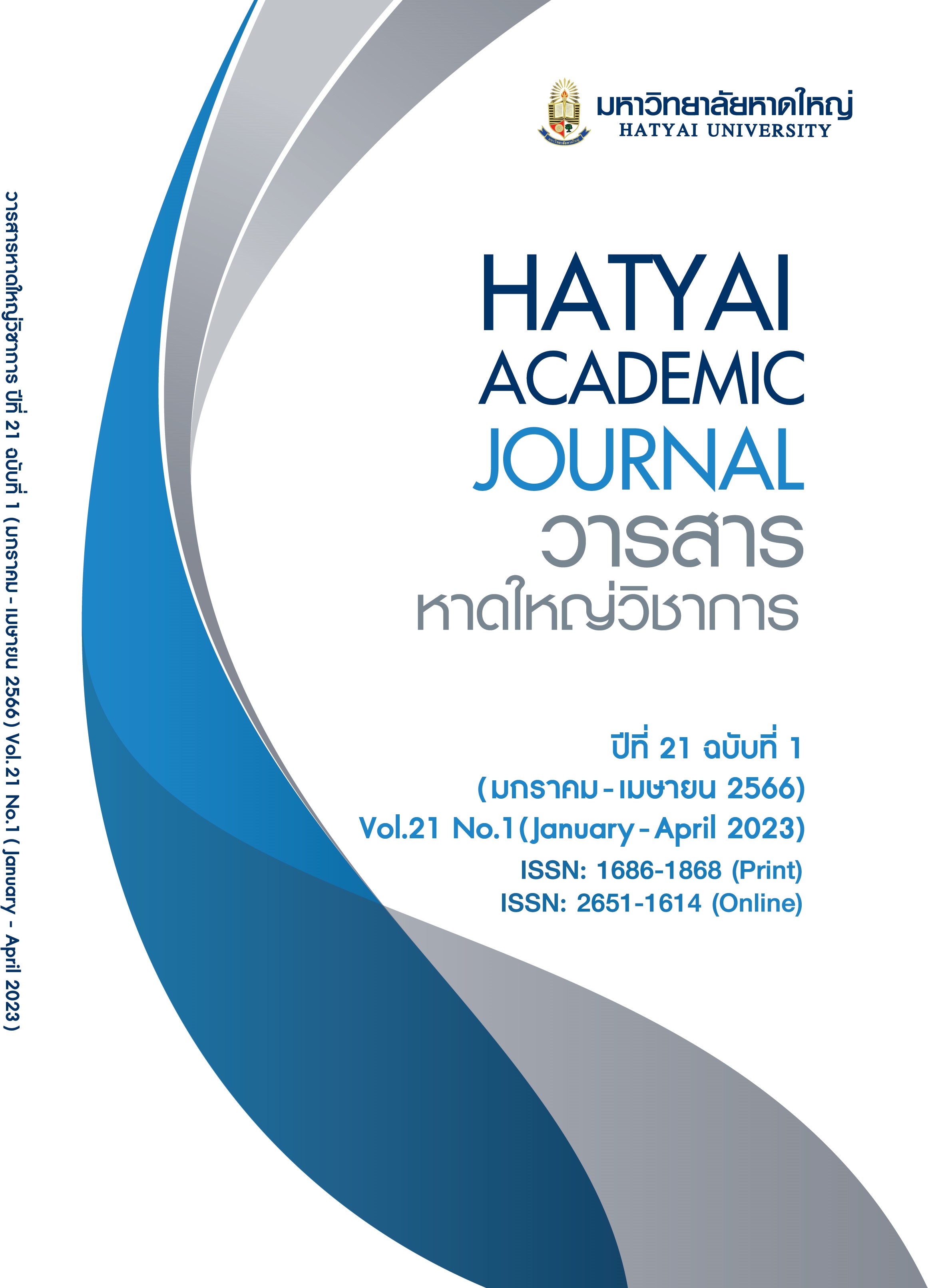การนำโมเดลสมการโครงสร้างแบบ Partial Least Square (PLS) เพื่อนำไปใช้ในการวิจัยด้านการจัดการเทคโนโลยี: การทบทวนวรรณกรรมอย่างเป็นระบบ
Main Article Content
บทคัดย่อ
บทความวิจัยนี้มีวัตถุประสงค์เพื่อหาข้อค้นพบของการนำวิธี Partial Least Square (PLS) สำหรับโมเดลสมการโครงสร้างเพื่อใช้ในการวิจัยทางด้านการจัดการเทคโนโลยี การทบทวนงานวิจัยแบบเป็นระบบได้วิเคราะห์ข้อมูล (จำนวนงานวิจัย) และนำเสนอผลการวิจัยจากการวิเคราะห์เพื่อให้ทราบทิศทางของงานวิจัยที่ใช้เครื่องมือแบบ PLS อีกทั้งงานวิจัยนี้ยังเสนอแนวทางการใช้เครื่องมือ PLS ดังกล่าวสำหรับงานวิจัยในอนาคตต่อไป งานวิจัยชิ้นนี้ใช้การรวบรวมงานวิจัยแบบเป็นระบบ ทำการค้นหางานวิจัยในหัวข้อการจัดการเทคโนโลยี ตั้งแต่ปี 2010 - 2020 จำนวน 155 บทความ ผลการวิจัยแสดงในรูปแบบสมการของเส้นแนวโน้ม (Trendline) มีค่าความชันแบบบวก โดยค่าความชัน (Slope) เท่ากับ 0.78 แสดงให้เห็นแนวโน้มการใช้วิธี PLS เป็นในทิศทางบวกมีการเติบโตเพิ่มขึ้น อีกทั้งงานวิจัยนี้ได้รวบรวมการวิเคราะห์และผลการวิจัยของทั้ง 155 ชิ้น นำมารวบรวมเพื่อนำเสนอแนวทางการนำเอา PLS ไปใช้ให้ถูกต้อง งานวิจัยนี้เป็นประโยชน์อย่างยิ่งกับนักวิจัยเพื่อทำให้การนำเอา PLS ไปใช้มีความถูกต้องและผลการวิจัยเป็นที่น่าเชื่อถือมากขึ้น
Article Details

This work is licensed under a Creative Commons Attribution-NonCommercial-NoDerivatives 4.0 International License.
ทุกบทความที่ได้รับการตีพิมพ์ ผ่านการประเมินจากผู้ทรงคุณวุฒิ (Peer Review) จำนวน 3 ท่าน จากหลากหลายสถาบัน โดยผู้ประเมินบทความไม่ทราบชื่อผู้เขียน และผู้เขียนไม่ทราบชื่อผู้ประเมิน (Double-blind Review) ข้อความและบทความในวารสารหาดใหญ่วิชาการเป็นแนวคิดของผู้เขียน มิใช่ความคิดเห็นของคณะผู้จัดทำ และมิใช่ความรับผิดชอบของมหาวิทยาลัยหาดใหญ่ กองบรรณาธิการวารสารหาดใหญ่วิชาการ ไม่สงวนสิทธิ์การคัดลอกบทความเพื่อใช้ประโยชน์ทางวิชาการ แต่ให้อ้างอิงแสดงที่มาของบทความ
References
Abhari, K., Davidson, E. J., & Xiao, B. (2017). Co-innovation platform affordances: Developing a conceptual model and measurement instrument. Industrial Management & Data Systems, 117(5), 458- 495.
Acosta-Prado, J. C., Navarrete, J. F. F., & Tafur-Mendoza, A. A. (2020). Relationship between conditions of knowledge management and innovation capability in new technology-based firms. International Journal of Innovation Management, 2150005.
Akter, S., D’Ambra, J., & Ray, P. (2011). Trustworthiness in mHealth information services: An assessment of a hierarchical model with mediating and moderating effects using Partial Least Squares (PLS). Journal of the American Society for Information Science and Technology, 62(1), 100-116.
Ali, F., Rasoolimanesh, S. M., Sarstedt, M., Ringle, C. M., & Ryu, K. (2018). An assessment of the use of Partial Least Squares Structural Equation Modeling (PLS-SEM) in hospitality research. International Journal of Contemporary Hospitality Management, 30(1), 514-538.
Basri, W. (2019). Investigating factors affecting the business management of Saudi food industry by SMART-PLS, measurement, and structural equation models: Moderating role of knowledge management. Industrial Engineering & Management Systems, 18(3), 426-439.
Bentler, P. M., & Chou, C. P. (1987). Practical issues in structural modeling. Sociological Methods & Research, 16(1), 78-117.
Bessonova, E., & Gonchar, K. (2019). How the innovation-competition link is shaped by technology distance in a high-barrier catch-up economy. Technovation, 86, 15-32.
Cepeda-Carrion, G., Cegarra-Navarro, J.-G., & Cillo, V. (2019). Tips to use Partial Least Squares Structural Equation Modelling (PLS-SEM) in knowledge management. Journal of Knowledge Management, 23(1), 67-89.
Chin, W. W., & Todd, P. A. (1995). On the use, usefulness, and ease of use of structural equation modeling in MIS research: A note of caution. MIS quarterly, 19(2) 237-246.
Colombo, M. G., & Rabbiosi, L. (2014). Technological similarity, post-acquisition R&D reorganization, and innovation performance in horizontal acquisitions. Research Policy, 43(6), 1039-1054.
Dewey, A., & Drahota, A. (2016). Introduction to systematic reviews: Online learning module cochrane training. Retrieved from https://training.cochrane.org/interactivelearning/module-1-introduction-conducting-systematic-reviews
Farooq, A., Laato, S., & Islam, A. N. (2020). Impact of online information on self-Isolation intention during the COVID-19 pandemic: Cross-sectional study. Journal of Medical Internet Research, 22(5), e19128.
Gabriel, M. L. D. D. S., & Da Silva, D. (2017). Diffusion and adoption of technology amongst engineering and business management students. International Journal of Innovation, 5(1), 20-31.
Hoyle, R. H. (Ed.). (2012). Handbook of structural equation modeling. New York: Guilford Press.
Hügel, S., & Kreutzer, M. (2020). The impact of organisational slack on innovative work behaviour: How do top managers and employees differ?. International Journal of Innovation Management, 24(3), 2050022.
Hwang, W. S., Choi, H., & Shin, J. (2020). A mediating role of innovation capability between entrepreneurial competencies and competitive advantage. Technology Analysis & Strategic Management, 32(1), 1-14.
Kline, R. B. (2011). Convergence of structural equation modeling and multilevel modeling. In M. Williams & W. P. Vogt (Eds.), The SAGE handbook of innovation in social research methods (pp. 562-589). Thousand Oaks, CA: SAGE.
Linton, J. D., & Thongpapanl, N. (2004). Perspective: Ranking the technology innovation management journals. Journal of Product Innovation Management, 21(2), 123-139.
Martínez-Cañas, R., Sáez-Martínez, F. J., & Ruiz-Palomino, P. (2012). Knowledge acquisition’s mediation of social capital-firm innovation. Journal of Knowledge Management, 16(1), 61-76.
Nunnally, J. C., & Bernstein, I. H. (1967). Psychometric theory, McGraw-Hill series in psychology. New York: McGraw-Hill.
Radosevic, S., & Yoruk, E. (2013). Entrepreneurial propensity of innovation systems: Theory, methodology and evidence. Research Policy, 42(5), 1015-1038.
Roxas, B., Battisti, M., & Deakins, D. (2014). Learning, innovation and firm performance: Knowledge management in small firms. Knowledge Management Research & Practice, 12(4), 443-453.
Samra, Y. M., Zhang, H., Lynn, G. S., & Reilly, R. R. (2019). Crisis management in new product development: A tale of two stories. Technovation, 88, 102038.
Santos-Vijande, M. L., López-Sánchez, J. Á., & Rudd, J. (2016). Frontline employees’ collaboration in industrial service innovation: Routes of co-creation’s effects on new service performance. Journal of the Academy of Marketing Science, 44(3), 350-375.
Segarra-Oña, M., Peiró-Signes, A., Albors-Garrigós, J., & Miguel-Molina, B. D. (2017). Testing the social innovation construct: An empirical approach to align socially oriented objectives, stakeholder engagement, and environmental sustainability. Corporate Social Responsibility and Environmental Management, 24(1), 15-27.
Shah, R., & Goldstein, S. M. (2006). Use of structural equation modeling in operations management research: Looking back and forward. Journal of Operations Management, 24(2), 148-169.
Singh, D., Khamba, J. S., & Nanda, T. (2017). Structural equation modelling of technology innovation model using AMOS for Indian MSMEs. International Journal of Productivity and Quality Management, 21(1), 72-96.
Sorooshian, S. (2017). Structural equation modeling algorithm and its application in business analytics. In M. Tavana, K. Szabat, & K. Puranam (Eds.), Organizational productivity and performance measurements using predictive modeling and analytics (pp. 17-39). IGI Global. https://doi.org/10.4018/978-1-5225-0654-6.ch002
Steelman, Z. R., Hammer, B. I., & Limayem, M. (2014). Data collection in the digital age: Innovative alternatives to student samples. MIS Quarterly, 38(2), 355-378.
Tabeau, K., Gemser, G., Hultink, E. J., & Wijnberg, N. M. (2017). Exploration and exploitation activities for design innovation. Journal of Marketing Management, 33(3/4), 203-225.
Teo, T., & Noyes, J. (2011). An assessment of the influence of perceived enjoyment and attitude on the intention to use technology among pre-service teachers: A structural equation modeling approach. Computers & Education, 57(2), 1645-1653.
Wamba, S. F., Gunasekaran, A., Akter, S., Ren, S. J. F., Dubey, R., & Childe, S. J. (2017). Big data analytics and firm performance: Effects of dynamic capabilities. Journal of Business Research, 70, 356-365.
Williams, C., & Nones, B. (2009). R&D subsidiary isolation in knowledge-intensive industries: Evidence from Austria. R&D Management, 39(2), 111-123.
